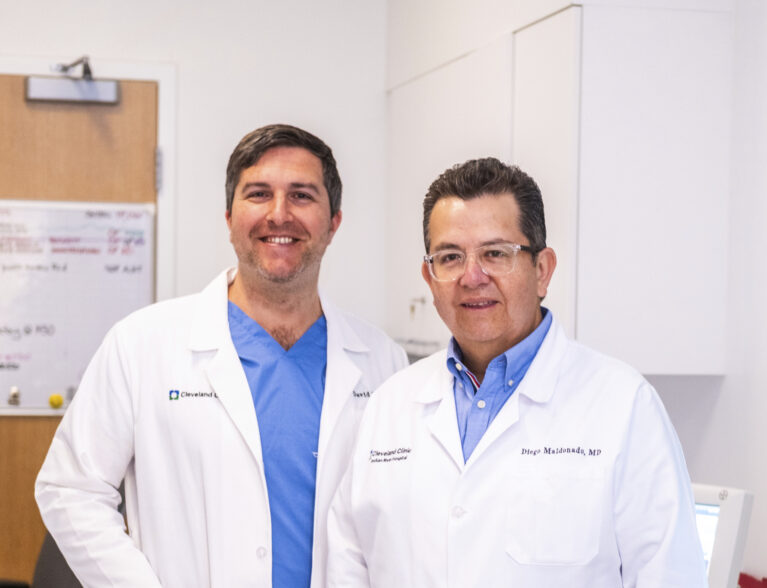
Pulmonary embolism is a widespread and often fatal affliction. As many as 600,000 cases occur in the United States annually and up to 30 percent of the time the patient dies within one month.
The high mortality rate is due in part to the lack of a standardized approach to treating PE.
To address this problem, Cleveland Clinic has assembled a multidisciplinary Pulmonary Embolism Response Team (PERT) consisting of a group of caregivers representing pulmonary and critical care medicine, vascular medicine, interventional radiology and cardiology, cardiothoracic surgery, hematology and pharmacy.
The team is available around the clock to provide rapid evaluation, risk stratification and management recommendations for PE patients. The group convenes via phone to collectively evaluate patients and their specific condition with the goal of rapidly executing optimal treatment.
“An embolism refers to the obstruction or blockage of the pulmonary artery” by a blood clot that typically comes from the deep veins in the legs or the pelvic area and travels to the lungs, according to Dr. Diego Maldonado, a pulmonologist with Cleveland Clinic Indian River Hospital.
“The pulmonary artery starts from the right ventricle, which is the right lower chamber of the heart. Then it branches out to both lungs, and from the main pulmonary arteries to the middle branches.
“There can be blockage at various levels – it could be on the main pulmonary artery, or it can be a smaller clot that blocks the different levels. The lobar pulmonary embolism blocks one or more of the main arteries, while subsegmental pulmonary embolisms are clots that lodge in the smaller branches of the pulmonary arteries. The larger clots will have more effect on the patient’s heart.
“One of the main risk factors for PE is deep venous thrombosis, which is a clot in your long extremity vein. Statistics say that 50 percent of patients with deep venous thrombosis have some level of pulmonary emboli on presentation. Overall, one out of thousand people get pulmonary embolism.”
If left untreated, or if misdiagnosed, PE can lead to severe complications, including heart failure and death. The high mortality rate is related to a lack of standardized treatments for acute PE and inconsistent decision making. Procedures can vary significantly from one hospital to another.
At Cleveland Clinic, when a patient is admitted to the emergency room with pulmonary embolism, the emergency physician will assess their risk and determine whether to activate the PERT team.
Patients judged as low risk with small clots but with normal blood pressure and no evidence of right ventricular strain are started on anticoagulants. For those deemed high-risk with hypotension and larger clots, there are several additional levels of treatment, including activation of the PERT team.
When that happens, team members are notified of an online meeting via email, instant messaging platform or dedicated pager number. The team draws on resources throughout the hospital, including the cardiac and interventional radiology labs and vascular ultrasonography suite, to devise targeted implementation. Within three hours of PERT activation, the team presents a treatment plan. If any of the team resources are deemed necessary, PERT mobilizes appropriate personnel to expedite intervention.
“Black-and-white medical evidence is straightforward. But in the gray zone, as we call it, there’s not enough evidence that we can place those recommendations for guidance.” Dr. Maldonado explained. “For some patients, there’s a lot of gray in evidence, so if the pulmonologist doesn’t feel comfortable making the call, he consults with other specialists in interventional radiology, critical care, vascular surgery and sometimes cardiology. We all have access to the images and laboratory tests that the ER doctor has performed. As a group we look at the case and come up with the best treatment.”
Dr. David Tabriz, a vascular and interventional radiologist, is another member of Cleveland Clinic’s PERT team. He said that having multiple physicians involved in decision making reduces the risk of patients undergoing unnecessary procedures.
“We are all simultaneously evaluating the patient. We all evaluate the imaging and the clinical scenario and determine if the patient is at risk of bleeding – because blood thinner is just one possible treatment – or whether or not they are a good candidate for either pure medication therapy verses more procedural intervention. It’s common sense that multidisciplinary care and evaluation will provide the best possible outcome. Studies have shown a high mortality reduction benefit to having a PE response team.
“Five years ago, if you had a severe PE clot burden in your lungs, you had to go for an open surgical removal with large incisions and a full anesthesia team. It was a risky procedure,” Dr. Tabriz continued. “Now, newer endovascular devices enable us to remove many clots through a needle hole, typically in the groin area.
“This has really changed PE management. If after discussing it with the PERT team everyone agrees for the pulmonary thrombectomy, then I’ll call in my procedure team and within the hour the patient is on the table, and we are starting to remove that clot.”
Depending on the severity of pulmonary embolism, treatment options can include:
- Anticoagulation therapy: In most cases, blood thinners are administered to prevent further clot formation and allow the body to dissolve the existing clot naturally.
- Thrombolytic therapy: In cases of higher-risk PE, clot dissolving medications called thrombolytics may be required to restore blood flow quickly and prevent cardiovascular collapse.
- Catheter-directed thrombectomy: For patients who have a large clot but cannot tolerate thrombolytics, minimally invasive surgical interventions may be performed to remove the clot directly.
- Traditional surgery: In the most extreme, life-threatening cases, traditional surgery where the chest is opened to access the clot may be required, according to the American lung association.
The emergence of PERT has revolutionized management of acute pulmonary embolism by integrating rapid diagnosis, multidisciplinary expertise and expedited treatment. The implementation of PERT has been shown to improve survival rates and shorten hospital stays by eliminating treatment delays and ensuring appropriate interventions. Hospitals with active PERT programs have reported better long-term outcomes for PE patients.
David Tabriz, M.D., is a vascular and interventional radiologist, and the site director and chair of Radiology at Cleveland Clinic Indian River Hospital. Interventional radiologists can treat various conditions and perform endovascular procedures such as deep venous and pulmonary embolism thrombectomy, ablation of tumors, and prostate artery embolization. He sees patients in-hospital at Cleveland Clinic Indian River Hospital.
Diego Maldonado, M.D., FCCP, is a pulmonary medicine and critical care specialist at Cleveland Clinic Indian River Hospital. He treats patients with lung cancer, pulmonary emphysema/lung volume reduction, pleural disease, pulmonary hypertension, asthma and pulmonary embolism. He sees patients at the hospital and at the Rosner Family Health and Wellness Center, 3450 11th Court, Vero Beach, 877-463-2010.



